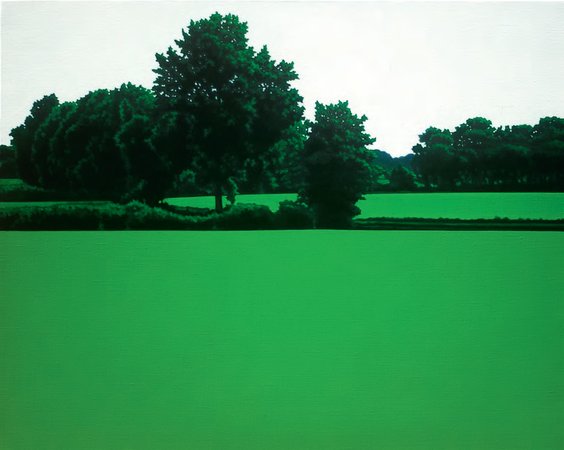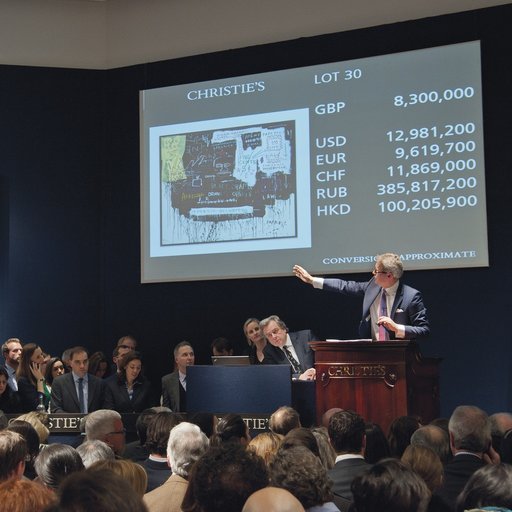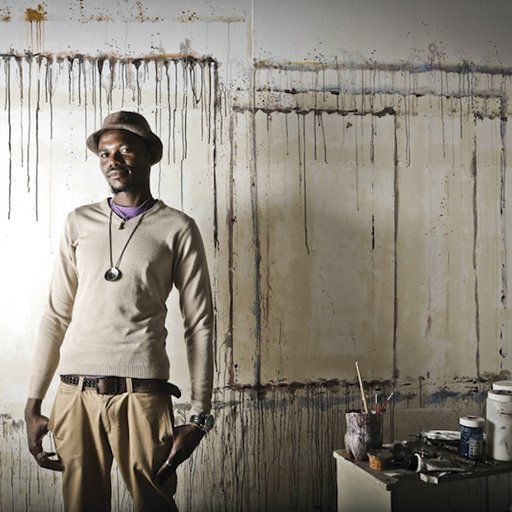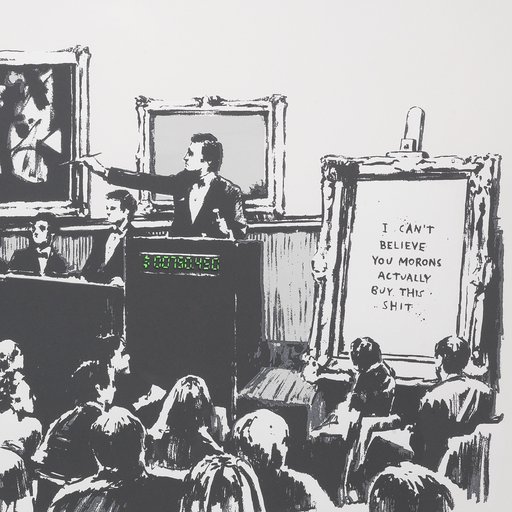You might think the landscape painting is a bit worn-out—stuck on 19th century romantic ideals and composed of passive scenes for the viewer to inhabit. Yet amongst the skilled and revolutionary artists in Phaidon's Vitamin P3, we've found three painters that are currently engaged in shaking up this supposedly vintage medium. Hailing from disparate regions and aesthetic approaches, these painters irreverently skirt the line between figuration and abstraction and reinterpret what the genre can be while subverting its traditional purposes and methods to make canvases with new depths of meaning. Check out their P3 excerpts below.
LUCAS ARRUDA
Born 1983, São Paulo, Brazil. Lives and works in São Paulo.

Brazilian painter Lucas Arruda faithfully returns to the same subject: painting seascapes and landscapes that are real, remembered, or simply imagined. His natural views, painted in an Impressionist style, have few distinguishing features, privileging instead the intangible connection between elements such as land and sky, or sky and sea in a celebration of the various qualities of light. Despite their ostensible realism, Arruda’s paintings frequently err into the territory of abstraction, provoking a detachment from the material world that can catalyze existential and emotional responses in the viewer.
Arruda paints quickly over one or two days in the studio, working on small canvases which he holds in his hand as he paints. The results are views that invite a sense of immediacy, and ask us to focus our attention onto a small surface. As he builds up and scrapes off layer upon layer of oil paint, the residue of this process gathers around the edges of the canvas, like the foam that bubbles on the sand in the wake of a wave. The intimate scale of the paintings requires viewers physically to lean in, called towards the picture so as to appreciate these painterly textures and visual effects. The artist explains the aura of his works: “Painting for me is like having a candle in the dark that allows you to see only what is close to you.”
Far from being retrograde, Arruda’s approach satisfies a thoroughly contemporary appetite for moments of calm and meditation; by exploring what landscape (or seascape) might mean as a concept, Arruda opens up a modern—and potentially radical—sphere of meaning for a traditional genre. In the absence of visual narrative, Arruda’s paintings are a balm for agitated souls, soothing the irritations of contemporary life and slowing down the process of looking in our accelerated and pictorially frenzied world. Arruda’s canvases even approximate the scale of handheld tablets and laptops, hinting at the importance of tactility in domains both artistic and technological. One imagines his paintings as constant companions, portable devices enabling aesthetic meditation at will.

Arruda’s works are installed on their own on large expanses of walls or sometimes hung in clusters, in a series of exhibitions that repurpose a single title: “Deserto-Modelo” (Desert-Model). The phrase makes reference to a line by the Brazilian poet João Cabral de Melo Neto: “We chose to build an enormous model.” The multiple meanings of “modelo” in the Portuguese title include “pattern,” “system,” and “an idealistic desert.” It is a term that captures the ambiguity and the potential of Arruda’s canvases to suggest infinity, evoking a sense of the sublime. If the square-on framing of his scenes, with their unfailingly level horizon, provides a pleasing and reassuring impression, the works’ subject—the sea—is associated with enormity and loss. In Arruda’s seascapes, the occasional identifying characteristic of time and place—a cloud on the horizon, a rock in the foreground—is usually archetypal and inconclusive, while the sea seems to be both the same and utterly different each time he paints it.
– Ellen Mara De Wachter
[related-works-module]
VALENTINA D’AMARO
Born 1966, Massa, Italy. Lives and works in Milan.

In Valentina D’Amaro’s work, landscapes represent a canon rather than a specific place. The flat green fields, leafy trees, aligned bushes, and white skies that characterize the vast majority of her production, whilst loosely based on photographs taken by the artist during research trips, do not reflect existing locations. They are, instead, fictional versions of how a landscape is commonly perceived—archetypical propositions designed to play around with the notion of what could plausibly and effectively exist, by giving the minimum amount of information. The ambiguity resulting from the combination of the stylized smoothness of the execution versus the sheer naturalism of the suggested scenario generates a picture with no narrative or apparent hierarchy between the elements involved. The horizon line is invariably positioned in the middle; the vegetation is sparse but rigorously balanced; the complex variations of tone typical of nature are reduced; and the predominance of green (a color conventionally associated with energetic equilibrium, and here deployed in different shades ranging from hypnotically bright to implosively dark) further implements the desire to propose an idealized dimension, conducive to meditation and relaxation. This is also borne out by the ostensible absence of inhabitants, a metaphysical solution that, on the one hand, reinforces the feeling of peaceful solitude, emphasizing the intimate relationship that mankind entertains with nature. On the other hand, it hints at the concept of painting as an image that, in order to cast its spell, must be activated through intelligent looking rather than being passively experienced as an illusory space to enter into.

In this context, D’Amaro’s refusal to reveal too much exemplifies the well-known principle that behind simplicity there is often variety and complexity. In their utopian aspiration to neutrality, her strictly untitled landscapes present some affinities with what the anthropologist Marc Aug. would define as “non-places”—transitional locations that do not deserve to be considered as proper places because of their anonymity, but that, in the end, become important precisely because of the immense imaginary potential their false sense of familiarity contains. If viewed from this perspective, even the contradiction of having bucolic, harmless scenes meticulously organized as if to look artificially perfect, subtly challenges the very values they seem to promote—the romantic twentieth-century idea of nature as a shrine of purity (where we can reconnect with our spiritual roots) rather than a mere backdrop to modern life.
Although D’Amaro has experimented with other subjects and media in the past, including portraiture and photography, figurative landscapes have occupied a central role in her practice for the past two decades. Such obstinate investigation of the same theme could be at first interpreted as the symptom of a representational crisis; yet the history of painting has proven on more than one occasion that it is in those moments when a subject is announced as exhausted that an artist feels compelled to tackle it, simply because there are still so many possibilities to be explored. D’Amaro’s decision to follow an established pictorial tradition by focusing on its blueprint has the bonus of depriving it of its temporal dimension, ultimately questioning our perception of nature as fixed and unchanging.
– Michele Robecchi
RAÚL RECIO
Born 1965, Santo Domingo, Dominican Republic. Lives and works in Santo Domingo.

Raúl Recio currently resides in HAll2000, an artist’s retreat he founded in a tiny rural community on the slopes of Pico Duarte, the highest mountain in his native Dominican Republic. The peak’s silhouette and lushly forested surroundings recur in Recio’s recent paintings as a correction to an historical oversight—namely, that of the early twentieth-century Swedish botanist Erick Ekman, whose diaries record his search for the peak he knew from reports as “Monte Tina,” but which for years he failed to identify even though, at around 9,850 feet, it towered over the Caribbean.
There is no chance of similarly overlooking the mountain in Recio’s eye-popping renderings: it shimmers at the centre of Monte Milagros (2015), like Paul Cézanne’s (1839–1906) Mont Sainte-Victoire, its physical topography layered with patriotic, spiritual, and even erotic projection. Where Recio’s provocative earlier career frequently confronted the sometimes harsh aspects of Dominican experience and national identity in a defiantly local vernacular, his recent paintings extend these concerns but relocate the site to his country’s deep interior. While these dense acrylics constitute a departure in medium, continuities in technique can be seen: Recio’s practice in woodcut, for example, can be read in the skillful handling of ink-like areas of flat black in Rio verde unos metros después (2015), and an emphasis on line, particularly in demarcating depth.

While his embrace of the rustic and tropical may at times resemble a brand of Caribbean kitsch, Recio’s landscapes are not idylls. The titular river of gold promised by Rios de Oro 8 (2015) is a putrid green, the high horizon and dark rock creating a feeling of looming threat. In Lomas de Oro 2 (2015) suggests fire, evoking something nasty just around the river bend. Initially enthralling, over time the whole picture begins to seethe and hum menacingly. Meanwhile, the sheer optical onslaught of these paintings—a simmering mix of rock, plant, and water which almost threatens to spill out of the canvas—implies a complementary struggle: that of the artist to capture the sprawling, throbbing density of the scene, as if wrestling with momentary sensation. This atmosphere of tension resonates with the report of Colombian writer and musician Rita Indiana, one of Recio’s champions, who describes life at HAll2000 as a steady confrontation with the unease of local communities, among them “alpha males with machetes.”
What redeems the currents of violent malaise on the one hand and the tendency towards garish idealization on the other, is the sheer intensity of Recio’s vision, which in the gleaming colors of Monte Milagros or the rhythmic repetition of the frond-like white line in Río de Oro 8 attains an ecstatic pitch. In such works, hazy colored dots float and bob like spores, or manna from heaven. With such psychedelic flourish, Recio offers another rebuke to the Suede Ekman: another view of the mountain, present, living, but unseen.
—Matthew McLean
[related-works-module]























